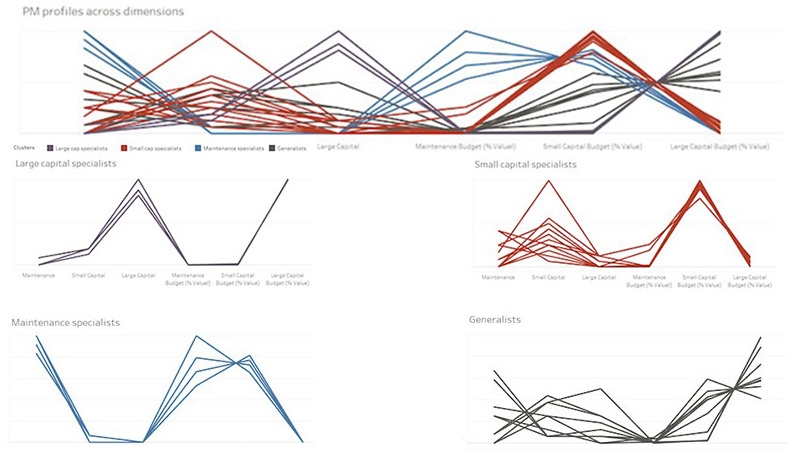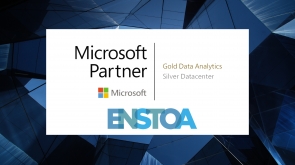
Machine Learning Offers Insights for Assembling Project Teams
Enstoa's clustering algorithm can evaluate team members strengths and personality traits to match them to projects they will perform well in and enjoy. These graphs charts a firm's project managers according to their level of specialization in areas such as large capital projects, small capital projects and maintenance work. Enstoa hopes these analytics will aid firms in building well balanced project teams.
Much of the research for AI in design and construction targets the project itself, making the most of the large volume of data collected during project life cycles. But the project team is also a good target.
“Our point of view is that technology is not delivering on its promises of productivity and innovation in the construction industry, not because of the technology itself, but the people involved,” says Jordan Cram, CEO of consulting firm Enstoa. His firm is taking machine learning and applying it to employee management, with the idea that a computer might notice team members’ hidden talents and preferences. “We have this ability to consider large amounts of data, so let’s apply these technologies to that organizational problem,” says Cram.
Enstoa takes the old corporate standby of personality tests, but rather than letting people game the system by overemphasizing their best qualities, it lets the AI find more subtle motivations in how people work. “We get 12 or 15 dimensions on each person, with the whole staff in the database,” explains Cram. “So when we need a new team with the values of X, Y and Z, we can use machine learning and statistical analysis to give us the best team for this situation.”
Employees are evaluated on topics ranging from their approach to problem solving to how well they want their goals defined in a project. These personality profiles are put through Enstoa’s clustering algorithm to look for the right grouping for the job at hand. Cram says the algorithm can spot employee qualities that a manager overseeing large teams could miss, citing an example of a project team member who prefers highly technical work but falls behind when given too much latitude
to work on multiple tasks at once. “We look in the database and find people who will find the work rewarding. One company we worked with has an EPC contract in Saudi Arabia and needed someone with more entrepreneurial values who wouldn’t get intimidated by the scale of the task, for example.” The company’s size made it hard to find the right person, but the algorithm found employees who showed interest. “We put these results in front of the manager and say, ‘What do you think?’ It’s another point of view and can be wrong, but it’s important to consider these hidden connections in the decision-making process.”
Link to the original article here.
Published in ENR on May 23, 2018
Enstoa's clustering algorithm can evaluate team members strengths and personality traits to match them to projects they will perform well in and enjoy. These graphs charts a firm's project managers according to their level of specialization in areas such as large capital projects, small capital projects and maintenance work. Enstoa hopes these analytics will aid firms in building well balanced project teams.
Much of the research for AI in design and construction targets the project itself, making the most of the large volume of data collected during project life cycles. But the project team is also a good target.
“Our point of view is that technology is not delivering on its promises of productivity and innovation in the construction industry, not because of the technology itself, but the people involved,” says Jordan Cram, CEO of consulting firm Enstoa. His firm is taking machine learning and applying it to employee management, with the idea that a computer might notice team members’ hidden talents and preferences. “We have this ability to consider large amounts of data, so let’s apply these technologies to that organizational problem,” says Cram.
Enstoa takes the old corporate standby of personality tests, but rather than letting people game the system by overemphasizing their best qualities, it lets the AI find more subtle motivations in how people work. “We get 12 or 15 dimensions on each person, with the whole staff in the database,” explains Cram. “So when we need a new team with the values of X, Y and Z, we can use machine learning and statistical analysis to give us the best team for this situation.”
Employees are evaluated on topics ranging from their approach to problem solving to how well they want their goals defined in a project. These personality profiles are put through Enstoa’s clustering algorithm to look for the right grouping for the job at hand. Cram says the algorithm can spot employee qualities that a manager overseeing large teams could miss, citing an example of a project team member who prefers highly technical work but falls behind when given too much latitude
to work on multiple tasks at once. “We look in the database and find people who will find the work rewarding. One company we worked with has an EPC contract in Saudi Arabia and needed someone with more entrepreneurial values who wouldn’t get intimidated by the scale of the task, for example.” The company’s size made it hard to find the right person, but the algorithm found employees who showed interest. “We put these results in front of the manager and say, ‘What do you think?’ It’s another point of view and can be wrong, but it’s important to consider these hidden connections in the decision-making process.”
Link to the original article here.
Published in ENR on May 23, 2018




